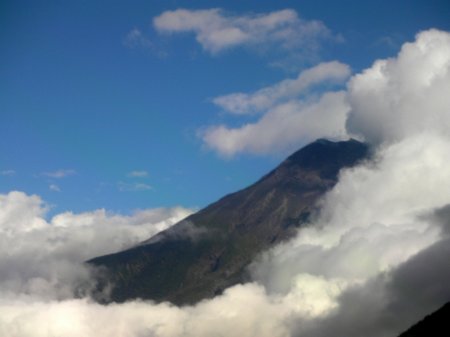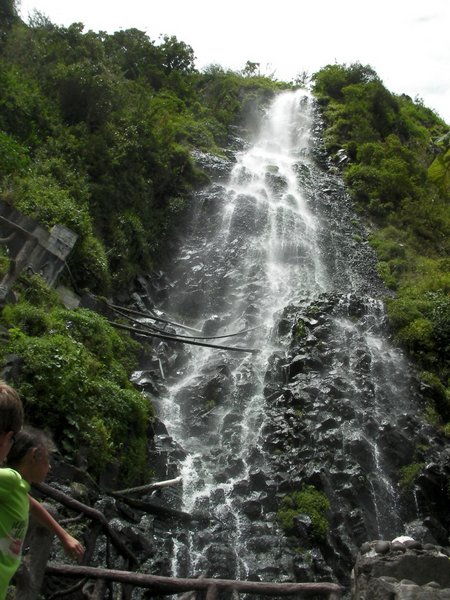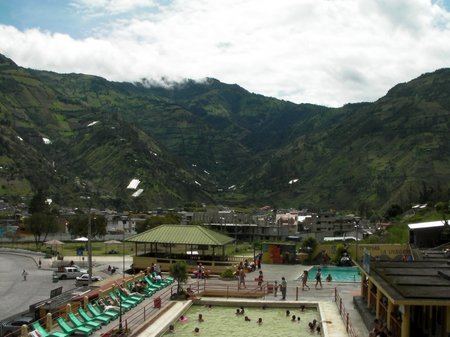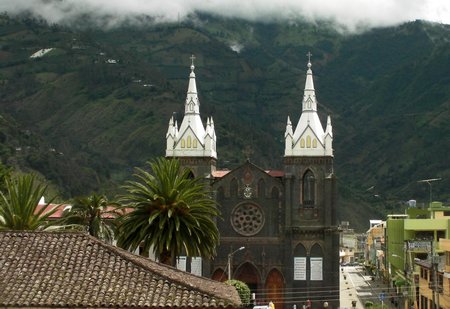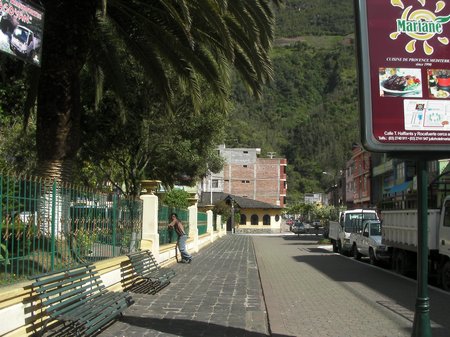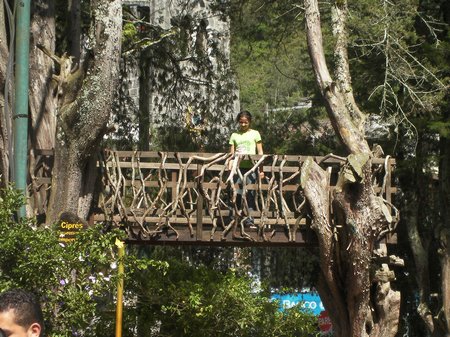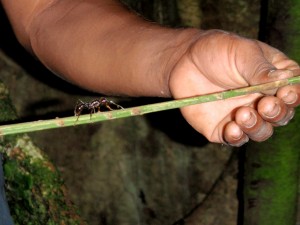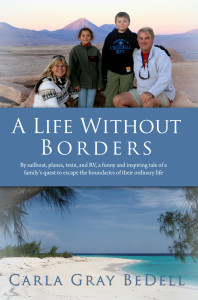After our Amazon adventure we headed back to the Chicago Hostel in Quito. The Chicago Hostel remained our base for the duration of our time in Ecuador. Once again we had to get acclimated, which meant a day or two of not feeling great. We did take a trip to the huge “American” Mall to see where wealthy Ecuadorians shop, but other than that, we remained pretty much at the hostel. By Monday, we were making plans for our new adventure. Our next stop was Banos, a small adventure filled town, elevation just under 6000 feet, at the base of the volcano Tungurahua.
When you talk to people in Quito, two of their favorite places to vacation in Ecuador are Mindo and Banos. Mindo was to the North so we decided it could wait and we headed south, down the “Avenue of the Volcanoes” to Banos. The trip involved our first time riding the Ecuadorian buses and we were a little nervous. Depending on which bus you took, or who you talked to, Banos was either a 3 or 4 hour bus ride from Quito. It involved a 30 to 60 minute taxi ride, depending on the horrific Quito traffic, to the Quito bus station on the south side of town. We were lucky that it took us only about thirty minutes, and for $8.00 that wasn’t bad. Buying a ticket was not as easy.
The Quito bus station seemed very new while the buses waiting for passengers seemed very tired. We weren’t in Peru anymore with their excellent buses. We tried to find the best looking bus line before we bought our ticket but they all looked the same. Even though the bus station was new, the tactics were old school. On one wall were 7 or 8 ticket counters, next to each other. The walls were divided by region. We found the region for Banos and as soon as we started toward the ticket area the ticket agents began yelling “Banos Banos Banos!” “Ambato!” “Banos” It was hard to think clearly. We bought our tickets on what we hoped was the “express” bus, one that didn’t stop at every small town on the way. Our bus didn’t leave for an hour so we explored the shops in the bus station. With 30 minutes left, the lady who sold us our tickets ran up and said something to us in Spanish. Tristan figured out that she said that the bus we bought tickets for wasn’t going and we had to take a different bus. Really, don’t ask me how he figured this out, but Tristan will definitely be getting an A in Spanish! To top it off, our bus was leaving in 5 minutes. The guidebooks had warned us that Ecuadorian buses LEAVE ON TIME. Of course we needed to use the rest rooms which were close by but meant we had to dig in our pockets for change and we had to go in shifts so we didn’t leave our luggage unattended. I was searching desperately in my pocket for 15 cents for Tessa, so she could use the rest room. Finally I just shoved her in while I dug out the change. Then I stood outside the bathroom yelling “Hurry up! We’re going to miss the bus!” Very classy. Once we were through with the rest rooms we still had to come up with more change for our departure tax. We were quite the spectacle, but unbelievably, we just made the bus.
The bus was fine. It was clean and the seats reclined a bit. It soon turned into a circus. Not too far from the bus station we stopped alongside the road to pick up more passengers. Boarding along with a few passengers were vendors. There was a guy selling ice cream, a woman selling drinks, someone else selling potato chips. They boarded the bus and walked down the isle selling their goods. This was surprising to us but our mouths really dropped open when a guy came on board selling meat on a stick. He had these shish-ka-bob sticks, about ten inches long, and the sticks were overflowing with chicken, sausages and vegetables. The food wasn’t wrapped up or covered, he was holding the bottom of the sticks in his hand walking through the crowded bus. Not very sanitary, but people bought them. They really did smell good. This wasn’t a one time thing either. On our four hour trip, on at least 6 different occasions, vendors came on board selling either food or CD’s.
As if the vendors weren’t distracting enough, our bus stopped everywhere to pick up people. So much for our “express” ticket. The driver even picked up people when all the seats were full. Where did those extra passengers sit? On the armrest of your seat. No kidding. For about a half hour Dan had to share his seat with an old man who was almost in his lap. It was a long trip.
Once we left Ambato, the last major city before Banos, the trip was downhill. We dropped from Ambato’s elevation of 8400 feet, down to around 6000 feet. It seemed the driver was reluctant to touch the brakes the entire way down, unless it was someone wanting a ride. At times as we were careening around hairpin curves we could see the volcano Tungurahua. Towering over 15000 feet I thought we would have a great view of the volcano, but Banos was built right up against the base of Tungurahua, so once we started the descent to Banos, we lost sight of it. But what we did see was magnificent.
Tungurahua is an active volcano. The Quichua named it tunguri (throat), rahua (fire), throat of fire and it’s an active volcano last erupting in February 2008. This was our first real encounter with an active volcano and to say the least, we were very excited. Well, Tristan and I were very excited, Dan and Tessa not as much. Tristan and Dan were sitting on the opposite side of the bus from Tessa and I. Sometimes the view of Tungurahua was better on their side than ours, and we excitedly pointed out the window, calling “Look! Look!” and quickly passed the camera back and forth. The first time we saw Tungurahua, we gasped. It was such a presence. It is so powerful and it knows it.
In Peru, the mountains were much taller and standing in a low valley like Colca Canyon, with the Andes towering above you with jagged peaks touching the sky, you felt safe. The mountains seemed like friendly grandfathers, looking down on you, watching out for you, protecting, loving. NOT Tungurahua. Nothing about Tungurahua seemed friendly; not in a malevolent way, but in the way of a supreme being. Tungurahua was not there to protect you or be your friend, Tungurhua was there to be respected, admired, worshiped. In Peru, the towering peaks stood shoulder to shoulder. In Ecuador, the mountains are more rolling, moving back in respect to give full view of the volcanoes. They know their place. The volcanoes in Ecuador are top dog and Tungurahua is one of the most respected.
Around five pm the bus dropped us at the bus station in Banos and under a light rain we scurried to find a Hostel. Plantas y Blancos (Plant and White) was the hostel we hoped to stay in. It is a very popular hostel and we were afraid it would be booked before we got there. Banos was not a big town and a few minutes of walking, and the help of direction from another traveling family, we arrived at the Hostel and took two of the last remaining rooms.
Plantas y Blanco, meaning plants and white and named for the white rooms adorned with lush green plants and vine covered walls, quickly became one of our favorite hostels. Because the 4 person dorm room was booked, we had two private rooms, with private bath and twin beds. (To clear up a misconception about hostels, you can get a room with a private bath. We never stayed in a hostel before because we thought we had to share a bathroom with strangers.) One of the rooms had a great view of the church Basilica de Nuestra Senora del Rosario de Agua Santa, which was beautifully lit at night. The hostel was wonderful. Our rooms were huge, so was our bathroom. There was a restaurant on the roof which served breakfast. The rest of the time the enormous kitchen was open for anyone to use. Half of the roof was enclosed in glass so you could sit inside, enjoy internet, look out through the wall of windows at the waterfall or sit outside and enjoy the fresh air. It was a great gathering place and we spent many nights talking to other travelers or playing the many games the hostel provided. Though our plans were to stay only two days, after seeing the town and the views, we knew we would be there much longer.
